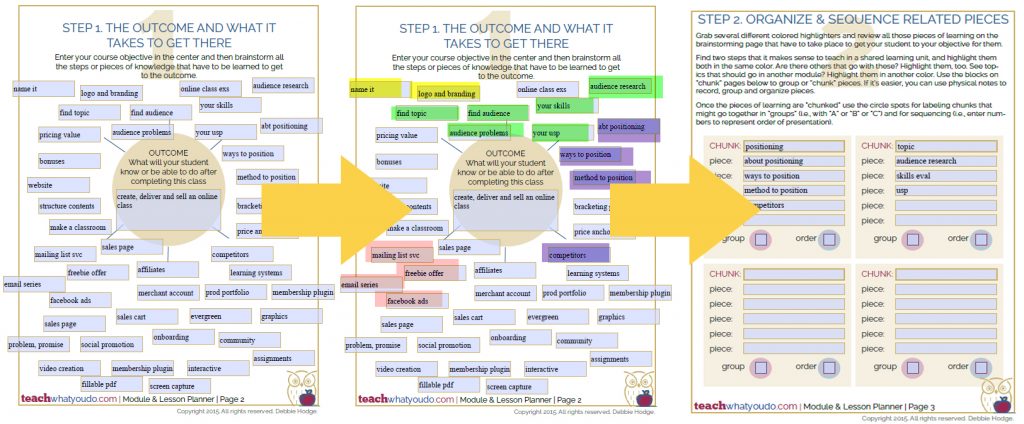
If you've got a talent, skill or body of knowledge you'd like to put to work in courses for others, there's a good chance you came to that talent through a WHOLE BUNCH of personal experience and effort.
That very experience that has given you something you know could benefit others can often be a big, many-armed octopus in the way of moving forward with online teaching.
- Perhaps you've got 6 scenarios you know your students might encounter and a diagnosis and prescription for each.
- Perhaps you know that to be truly healthy your student will need to make significant changes to their beliefs and pursue a number of actions from prayer to exercise to community to diet.
- Perhaps you've got a system for refinishing furniture or becoming a pastel painter or learning to stage homes — but you cannot imagine teaching your expertise without also including instruction on more elementary aspects of your topic.
Am I speaking to you? Has the sheer scope of all you believe you need to teach your students got you stuck, circling around the octopus of your topic, trying to hug and contain it and yet moving around and around but not forward?
Here are 3 steps you can take to rein in your ideas and find the focus to take that first step forward.
1. Niche down and focus on ONE “avatar” or target audience.
I'm not saying you can't serve all of your avatars eventually, but to wrangle this octopus that is your class idea right now, you'll benefit from focus.
In addition to Teach What You Do, I own GetItScrapped.com where I've created and sold 100s of online courses since 2007. If you asked me who I serve there, who my avatars are, I'd tell you about these three women.
Ashley is a 34-year-old mother of 2 girls who admires Martha Stewart and takes pride in (sometimes extreme) creative pursuits that might include birthday cake decorating, making a gallery wall in her child's room, or creating scrapbooks that record her life with her family. She enjoys the creative pursuits and the enduring result of them and she wants her work to be of high quality.
Rae is a 44-year-old working mother of teenagers who journals and scrapbooks, dabbles in mixed media and even digital arts to express her feelings about her own life. She pursues this creative work at night after work and on weekends and it infuses her with purpose and joy.
Nancy is a 68-year-old grandmother who travels occasionally and who enjoys learning new creative skills as she scrapbooks photos of her family, her daily life, and her travels. She wants her scrapbooks to be more than photos; she wants them to express the reality of these moments with journaling and techniques and design that all come together is a well-designed and meaningful piece.
I can serve all three avatars now–but when I started out, it was Ashley I was first serving, as I focused on teaching layout design and visual storytelling to over-the-top crafters.
So go ahead and create your avatars–be specific, name them and their family members and their activities and their telling possessions and beliefs. And then: CHOOSE ONE AVATAR to serve in your initial venture.
2. Do a brain dump on your topic and then chunk it down to find a sliver of your entire class to start with.
Let's just lay it all out on the table. Grab a piece of paper–or our “Break Your Course Idea Into Manageable Chunks” fillable pdf (click on the gold bar at the bottom of the post) and put the outcome you want to teach your students to achieve in the center. Put a circle around it.
Now: dump out all the pieces you can think you'd need to teach –into as many arms as you need. Here's a look at how I did that for the eCourse Blueprint at Teach What You Do.

With the many pieces of teachable knowledge detailed, grab several colored highlighters or pens and start marking the pieces that go together in the same color. Here I've got the pieces that go toward choosing a course topic in green, positioning in purple, and list building in pink.
I call this “chunking” things, and once I've got my chunks I can start to organize a full-fledged course into modules or lessons.
But what I want you to do know is to CHOOSE ONE CHUNK to zero in on. Choose a chunk that you could see being useful to that avatar you've chosen to focus on as you get started. This chunk is something your avatar could use now.
That's what I want you to start with right now. Make a written lesson or a worksheet or a presentation that you could deliver live or recorded.
This first lesson might be something you sell. It might be your first lead magnet. The important thing is, you've briefly put your arms around that octopus and found one arm to shake–or maybe just one suction cup on one arm. The point is you're no longer dealing with the whole beast (and I say “beast” affectionately because most of us love the beast of our great ideas). You're now dealing with a manageable aspect of it.m
3. Coach one or two or three individuals who match your avatar.
If you're serious about teaching online, you should be hanging out in communities where you can listen and engage with folks who might buy your {eventual} course.
Put out an offer to help a few individuals at no cost. That's right! Make it known that you're working on an online course on a topic these people are interested in because you've got expertise. Tell them that in order to better understand exactly what should go in the course, you've got 3 spots for free personalized coaching on the topic–two or three sessions per person. You can meet on Skype or with a web conferencing tool.
Get ready to LISTEN a whole bunch at the beginning. Work to understand just what it is these people need and then give it to them as best you can.
You'll come out of these sessions with a new understanding of which aspects of that big old octopus of ideas you've got really matter–and then you can get back to your brain dump and your chunks from step 2 and create another lesson or mini-course or lead magnet.
This approach never gets old. In fact, the impetus and ideas for this article you're reading now came out of a live conference call with one reader and a lengthy email correspondence with another. My prospects are always teaching me what they need most.
So what do you think?
Are you ready to embrace your own many-armed, wriggling idea of what your course should be and find focused elements you can move forward with now.
Octopus-taming skills will come in useful for you again and again as you launch and pilot your own online teaching business. At least once per month, I've got to hug and disentangle an octopus–whether that be to figure out how I'm going to engage regularly with my readers, create a new product that fits well into my funnel, or develop a lead magnet that will attract the right prospects. I usually grab an 11″ x 17″ piece of cardstock and start diagramming or just dumping my ideas. A day or two later I come out the other side with my solution. What always surprises me is how simple the solution ends up being. And yet I couldn't see it until I sat down and teased that simple solution out.
To help you with your own idea-taming, we've got the “Break Your Course Idea Into Manageable Chunks” worksheet–print it or download, fill digitally, and save locally. Click the gold bar above to get it.
